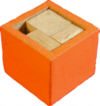 Cut and fold a 3 X 5 card to
make this.
Cut and fold a 3 X 5 card to
make this. |
 Can you place 31 dominoes on
the 62 squares? (Two of the chessboard squares are gone.)
Can you place 31 dominoes on
the 62 squares? (Two of the chessboard squares are gone.) |
 Pack the blocks (18) in
the box.
Pack the blocks (18) in
the box. |
 Pack the blocks (6) in the box.
Pack the blocks (6) in the box. |
 Arrange the ellipses so
that the closer they are, the more similar--and the more similar, the closer.
Arrange the ellipses so
that the closer they are, the more similar--and the more similar, the closer. |
| This one is spatial visualization, not abstract math. The insights into the mathematical abstractions generally develop at the beginning of adolescence. Children may see it when their parents don't. |
Counting
squares to discover that 62 = 62 is only a beginning here. Noticing
that a parity relationship exists is a very small step, but it's a step
toward the more abstract...seldom seen. It is, however, very easy
to see. |
This
puzzle is virtually unsolvable by trial and error. The arithmetical
principle of the smaller puzzle (to the right) is a virtual necessity for
this puzzle.
Construction instructions below. |
This
puzzle yields easily to trial and error. It can, however, be solved
by a simple arithmetical principle.
...and it's the same principle that solves the 5X5X5 cube puzzle to the left
|
This
puzzle has, in our opinion, as great a potential toward more effective
understanding of the role of mathematics and science in human life as can
be found. Click on the picture to see how our concept of measure has been expanded in ways seldom seen. |
